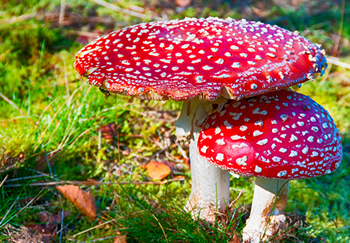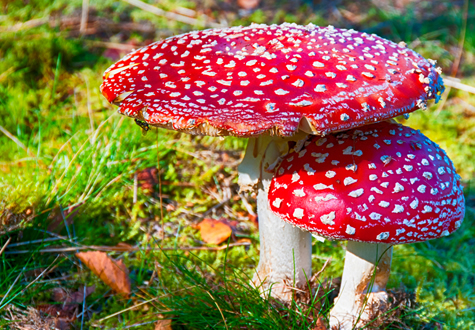
This article on poisonous mushrooms has been repurposed from The Antidote, a newsletter of the Blue Ridge Poison Center.
Spring in Virginia often results in a bountiful mushroom-growing season. Many outdoor enthusiasts forage for edible, wild mushrooms. But beware: Some wild mushrooms can make you very sick, and some poisonous mushrooms can kill.
And because the differences between types of mushrooms can be so slight, even an experienced mycologist (mushroom scientist) can make a mistake. So how can the average person tell if a mushroom is safe to eat? The answer: You can’t.
Identifying Mushrooms: Why it’s So Hard
Unfortunately, simple guidelines for identifying mushrooms do not exist. Foragers must consider many things, including:
- Color of the mushroom
- Color of the spores underneath the cap
- Shape and texture of the cap
- Presence and appearance of gills beneath the cap
- The appearance of the stalk, including the very bottom of the stalk below the surface of the ground
- How the cap is attached to the stalk
- Whether the mushroom grows alone, in a cluster, or in a circle
- What the mushroom is growing on
- What trees are nearby
Other complicating factors: A mushroom’s characteristics change as it matures, and mushrooms vary from region to region.
Poisonous Mushrooms: Myths vs. Facts
And then there’s the lore. People pass along misinformation about how to distinguish edible mushrooms from poisonous species, like the following:
Myth: Poisonous mushrooms always have bright, flashy colors.
Fact: Toxic species can be pure white or plain brown.
Myth: Snails, insects or other animals won’t eat poisonous mushrooms.
Fact: Just because a mushroom doesn’t hurt another animal doesn’t mean it won’t hurt you.
Myth: Silver or onions blacken toxic mushrooms on touch.
Fact: All mushrooms darken or bruise if damaged.
Myth: Toxic mushrooms smell and taste horrible.
Fact: Some say toxic mushrooms actually taste very good.
Myth: Any mushroom becomes safe if you cook it.
Fact: You can’t make a toxic mushroom safe by cooking, canning, freezing or drying.
Play it Safe
Due to so many mushroom types and complex factors, don’t eat wild mushrooms unless accompanied by an expert — and you’re willing to take the risk.
Protect children, too, who may not understand the difference between wild mushrooms and store‐bought ones. Watch young kids closely when outdoors, and instruct older children that they should never eat any wild plants, berries or mushrooms.
The Symptoms of Eating Poisonous Mushrooms
Mushroom poisoning may not show symptoms for hours or even days after ingestion, when the toxins have begun to attack the liver and other organs. Certain species can cause hallucinations, dizziness, drowsiness, dilated pupils or muscle spasms. Other species cause severe vomiting, diarrhea and sharp abdominal pain. The most dangerous species found in Virginia belongs to the Amanita genus; even one bite can be life‐threatening.
Avoid Common Poisons
See how at the Blue Ridge Poison Center.
If you suspect someone may have eaten poisonous mushrooms, seek medical help immediately. Don’t wait for symptoms to develop. If possible, try to collect a sample of what the person ate to help experts make an accurate identification.
